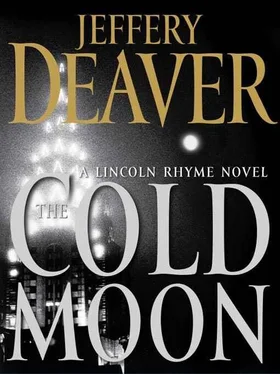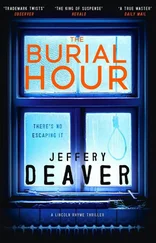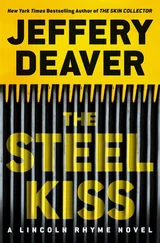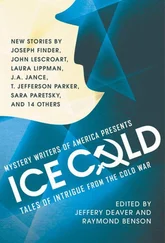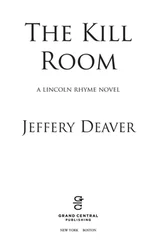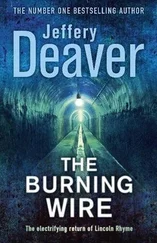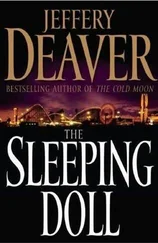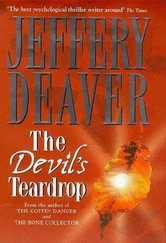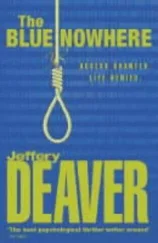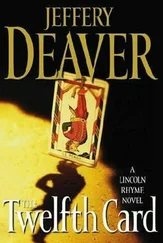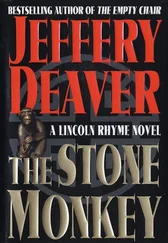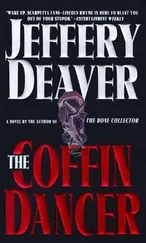A call to the publisher resulted in no cooperation, which didn't surprise Rhyme. He was told they didn't sell the book directly to readers and if Rhyme wanted to find out what retail outlets bought the book in quantity a court order would be necessary. It would take weeks to get one.
"Do you understand," Dennis Baker snapped into the speakerphone, "that somebody's using this as a guidebook to torture and kill people?"
"Well, that's sort of what it's for, you know." The head of the company hung up.
"Goddamn."
Continuing to look over the evidence, they learned that the grit and leaves and cinders that Pulaski had extracted from the grille, the tire treads and sideview mirrors were not distinctive. The trace in the back bed of the SUV revealed sand that matched what the prep had used as the obscuring agent in the Cedar Street alleyway.
The crumbs were from corn chips, potato chips, pretzels and chocolate candy. Bits of peanut butter crackers too, as well as stains from soda-sugared, not diet. None of this would lead them to a suspect, of course, but it could be another plank in the bridge connecting a perp to the Explorer if they found one.
The short cotton fibers-flesh-colored-were, as Pulaski suggested, similar to those shed by a generic brand of work gloves sold in thousands of drugstores, garden shops and grocery stores. Apparently they'd meticulously wiped the Explorer after they'd stolen it and worn gloves every time they were inside the vehicle.
This was a first. And a reminder of the Watchmaker's deadly brilliance.
The hair from the headrest was nine inches long and was black with some gray in it. Hair is good evidence since it's always falling out or is being pulled out in struggles. Generally it offers only class characteristics, though, meaning that a hair found at a scene will provide a circumstantial connection to a suspect who has similar hair, based on the color, texture, length or presence of dye or other chemicals. But hair generally can't be individuated: that is, it can't be linked conclusively to the suspect unless the follicle's attached, allowing for a DNA profile. The hair that Pulaski found, though, had no follicle.
Rhyme knew it was too long to be the Watchmaker's-the EFIT picture, according to Hallerstein, depicted medium length. It might have been from a wig-the Watchmaker could be using disguises-but Cooper could find no adhesive on the end. His assistant had worn a cap and it could have come from him. Rhyme decided, though, that the hair had probably come from someone else-a passenger riding in the SUV before the Watchmaker stole it. A nine-inch hair could be a man's or a woman's, of course, but Rhyme felt that it was probably a woman's. The gray suggested middle age and nine inches was an odd length for a man of that age to wear his hair-shoulder length or much shorter would be more likely. "The Watchmaker or his assistant may have a girlfriend or another partner but that doesn't seem likely… Well, put it on the board anyway," Rhymeordered.
"Because," Pulaski said, as if reciting something he'd heard, "you just never know, right?"
Rhyme lifted an eyebrow. Then he asked, "Shoes?"
The only footprint Pulaski had found was from a smooth-soled, size-thirteen shoe. It was just past a pool of water the wearer had stepped in; he'd left a half dozen prints on the way to the exit before they faded. Pulaski was pretty sure it was the Watchmaker's or his partner's, since it was on the most logical route from the Explorer to the nearest exit. He'd also noted that there was some distance between the prints and only a few of them displayed the heel. "Means he was running," Pulaski said. "That wasn't in your book. But it made sense."
It was hard to dislike this kid, Rhyme reflected.
But the print was only marginally helpful. There was no way to determine the brand because the leather had no distinctive tread marks. Nor were there any unusual wear patterns, which might indicate podiatric or orthopedic characteristics.
"At least we know he's got big feet," Pulaski said.
Rhyme muttered, "I missed that statute where it says someone with size-eight feet is prohibited from wearing size-thirteen shoes."
The rookie nodded. "Oops."
Live and learn, thought Rhyme. He looked over the evidence again. "That's it?"
Pulaski nodded. "I did the best I could."
Rhyme grunted. "You did fine."
Probably not very enthusiastic. He wondered if the results would've been different if Sachs had been walking the grid. He couldn't help but think they would be.
The criminalist turned to Sellitto. "What about the Luponte file?"
"Nothing yet. If you knew more it'd be easier to find."
"If I knew more, I could find it myself."
The rookie was staring at the evidence boards. "All this…and it comes down to we hardly know anything about him."
Not exactly true, Rhyme thought. We know he's one goddamn smart perp.
THE WATCHMAKER
CRIME SCENE ONE
Location:
Repair pier in Hudson River, 22nd Street.
Victim:
Identity unknown.
Male.
Possibly middle-aged or older, and may have coronary condition (presence of anticoagulants in blood).
No other drugs, infection or disease in blood.
Coast Guard and ESU divers checking for body and evidence in New York Harbor.
Checking missing persons reports.
Perp:
See below.
M.O.:
Perp forced victim to hold on to deck, over water, cut fingers or wrists until he fell.
Time of attack: between 6 P.M. Monday and 6 A.M. Tuesday.
Evidence:
Blood type AB positive.
Fingernail torn, unpolished, wide.
Portion of chain-link fence cut with common wire cutters, untraceable.
Clock. See below.
Poem. See below.
Fingernail markings on deck.
No discernible trace, no fingerprints, no footprints, no tire tread marks.
CRIME SCENE TWO
Location:
Alley off Cedar Street, near Broadway, behind three commercial buildings (back doors closed at 8:30 to 10 P.M.) and one government administration building (back door closed at 6 P.M.).
Alley is a cul-de-sac. Fifteen feet wide by one hundred and four feet long, surfaced in cobblestones, body was fifteen feet from Cedar Street.
Victim:
Theodore Adams.
Lived in Battery Park.
Freelance copywriter.
No known enemies.
No warrants, state or federal.
Checking for a connection with buildings around alley. None found.
Perp:
The Watchmaker.
Male.
No database entries for the Watchmaker.
M.O.:
Dragged from vehicle to alley, where iron bar was suspended over him. Eventually crushed throat.
Awaiting medical examiner's report to confirm.
No evidence of sexual activity.
Time of death: approximately 10:15 P.M. to 11 P.M. Monday night. Medical examiner to confirm.
Evidence:
Clock.
No explosives, chemical- or bioagents.
Identical to clock at pier.
No fingerprints, minimal trace.
Arnold Products, Framingham, MA.
Sold by Hallerstein's Timepieces, Manhattan.
Poem left by perp at both scenes.
Computer printer, generic paper, HP LaserJet ink.
Text:
The full Cold Moon is in the sky,
shining on the corpse of earth,
signifying the hour to die
and end the journey begun at birth.
– The Watchmaker
Not in any poetry databases; probably his own.
Cold Moon is lunar month, the month of death.
$60 in pocket, no serial number leads; prints negative.
Fine sand used as "obscuring agent." Sand was generic. Because he's returning to the scene?
Metal bar, 81 pounds, is needle-eye span. Not being used in construction across from the alleyway. No other source found.
Duct tape, generic, but cut precisely, unusual. Exactly the same lengths.
Читать дальше
